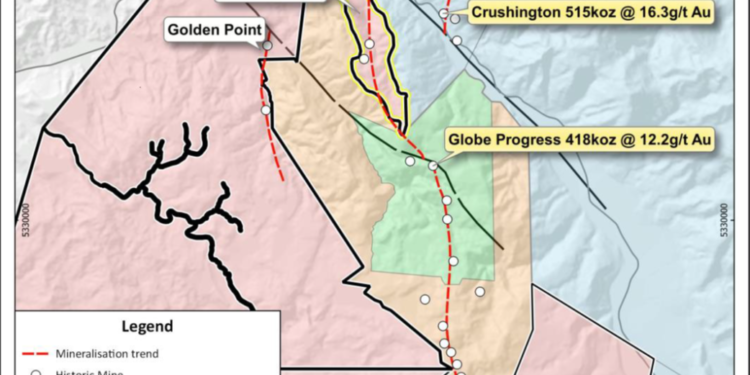Siren Gold Limited (ASX: SNG) has encountered strong gold anomalies in early exploration work at the Auld Creek Prospect in New Zealand.
Highlights
• The Auld Creek mineralisation lies between the Crushington (515koz @ 16.3g/t Au) and Globe Progress (418koz @ 12.2g/t Au) historic mines.
• Two north-south trending gold and arsenic soil anomalies were defined along the line of the Bonanza and Fraternal reefs for around a 700m long strike. Trenching across these anomalies encountered strongly brecciated gold and stibnite mineralisation, returning results of 2m @ 8.6g/t Au and 1.7%Sb across the Bonanza reef, and 2m @ 5.6g/t Au and 2.3%Sb across the Fraternal reef.
• Between 1996 and 2013, Oceana Gold Limited (OGL) drilled 17 diamond holes for 2,016m, defining a mineralised zone up to 13m true width. The Fraternal mineralisation strikes north-south for over 100m, hosted in a steeply west-dipping shear zone parallel to a small anticline hinge.
RDD0085 intersected a true width of 13m @ 1.6g/t Au from 30m in, including 3m @ 3.0g/t Au and 3.7m @ 2.6g/t Au. RDD0087 intercepted a true width of 6m @ 4.1g/t Au from 63m, including 3m @ 5.7g/t Au.
The highest grades in the deposit are generally associated with strong stibnite mineralisation. The deepest drillhole intersected gold mineralisation less than 100m below surface, and mineralisation remains open at depth and along strike.
Background
The Auld Creek Prospect is contained within Siren’s Golden Point exploration permit and is situated between the highly productive Globe Progress mine, which historically produced 418koz @ 12.2g/t Au, and the Crushington group of mines that produced 515koz @ 16.3 g/t Au.
More recently OGL mined an open pit and extracted an additional 600koz from lower grade remnant mineralisation around the historic Globe Progress mine.
The Auld Creek mineralisation extends for over two km and appears to represent a block that was potentially offset to the west, along NE-SE trending faults between Globe Progress and Crushington.
Arsenic and gold soil geochemistry from Big River to Crushington appears to confirm this interpretation. The gap in soil geochemistry north of Big River is due to the presence of coal measures that overly the Greenland Group sediments that host the gold mineralisation.
The Globe Progress mining permit was surrendered by OGL and has subsequently, been split into the Globe Progress Reserve and Siren Golds Globe Surrounds Tender Application area.
The Reserve Area is quarantined until 6 December 2023, while OGL is rehabilitating the mine site. The remaining area was opened for permit applications in a tender process. Siren Gold lodged an exploration permit application, but New Zealand Petroleum and Minerals (NZPaM) has not yet decided on the successful party.
Exploration – Next Steps
The Energetic at Crushington was mined to around 600m and Globe Progress was mined to around 420m below surface where the mineralisation was offset by the Chemist Shop Fault. The mineralisation on the other side of the fault has not been found and remains to be re discovered. The existing drillholes at Auld Creek have only tested the mineralisation to less than 100m below surface and 150m along strike.
Additional drilling is required to:
• Test for extensions for Fraternal of the mineralisation along the 700m soil anomaly.
• Drill some deeper holes to define the plunge of the Fraternal shoot and test the grade and thickness of mineralisation to around 500m below surface.
• Only one hole has been drilled in the Bonanza reef. Additional drilling is required to test this reef along strike and down dip.
For further information please visit: https://www.sirengold.com.au












